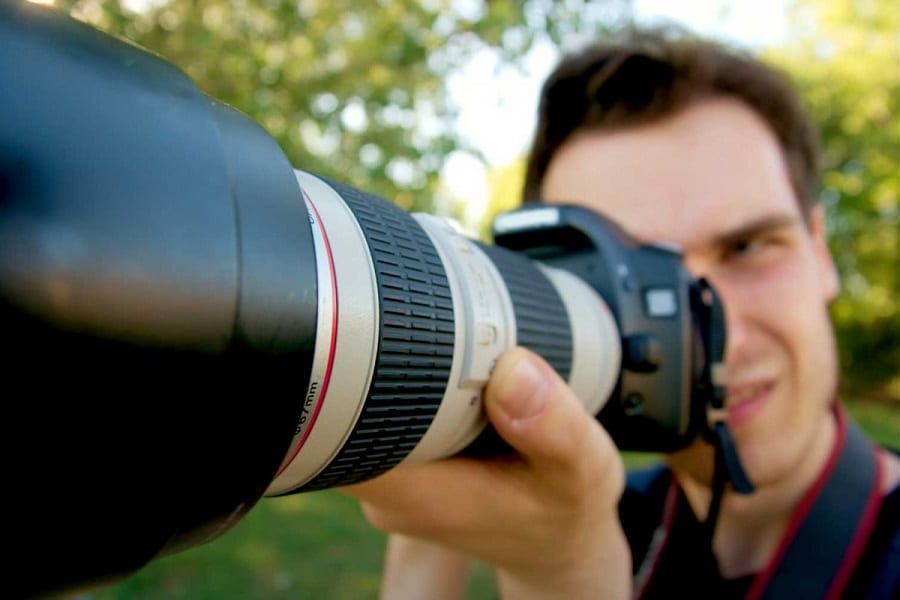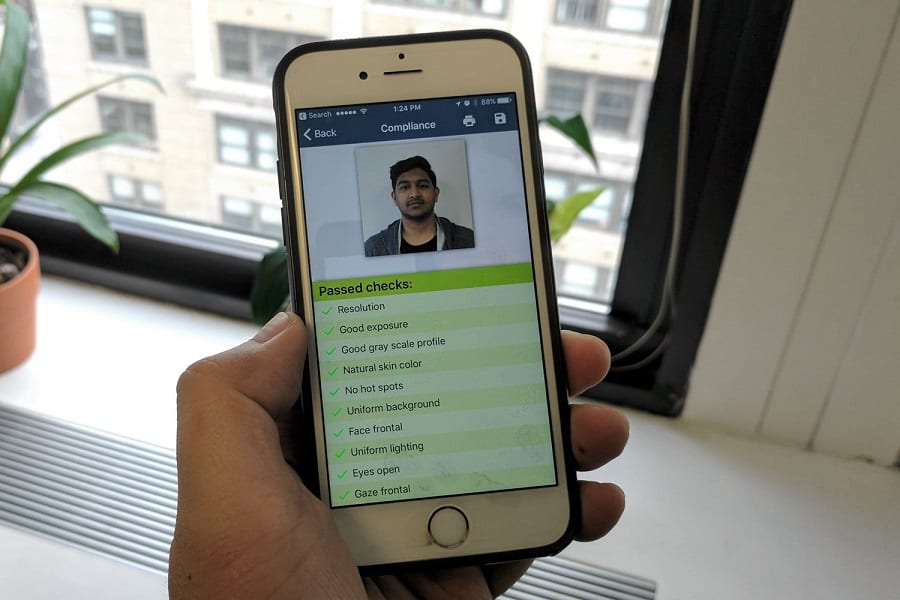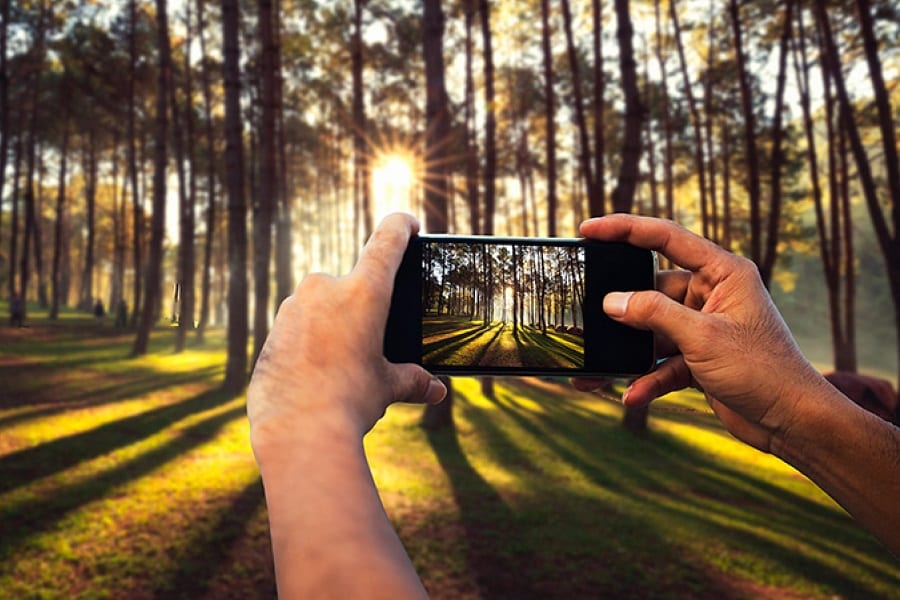Lighting is one of the most important aspects of taking high-quality photographs.
It can make or break a scene, draw attention to the right places, or instantly make someone look heavier or lighter in a photo.










For those of us taking photographs of products or listing items for sale, the best photo lightbox takes care of all lighting conditions that put our subject in the right light.
Photo lightboxes are designed to eliminate shadows, and provide a high level of contrast between the photo’s subject and the background.
With these, you’re dealing with all-white backgrounds to really show off the features of the photo’s subject, but there’s more to it than that.
You have to worry about the size, lumens, portability, and more. We’re going to cover all of that right now.
Best Photo Studio Box
AmazonBasics Portable Foldable Photo Box LED Studio
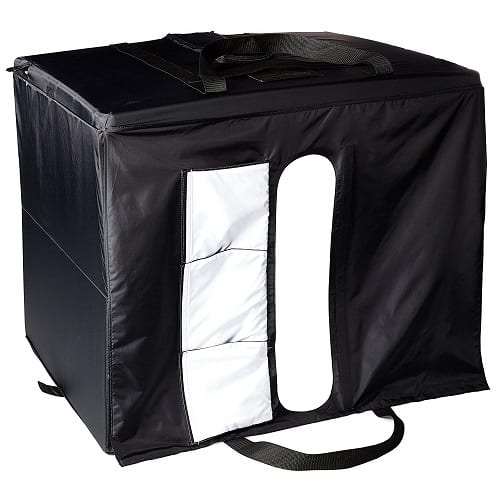
No matter which way you swing it, AmazonBasics just knows how to hit the nail on the head without charging you an arm and a leg.
Their simple photo lightbox gets the job done properly, regardless of what you’re photographing.
It’s a bit heavy for a lightbox at 14 pounds, but still portable at the same time.
You can fold this up entirely to carry it with you in a 25” x 30” case, making it simple if you’re travelling for clients and taking photographs of items on-set or on-location.
Amazon has thought of just about everything regarding this lightbox, including a three-door system on the front for optimal viewing angles of whatever it is you’re photographing inside the lightbox.
Additionally, you can also exclusively remove the top to take aerial photographs. This works wonders if it’s a large item and that fourth side wall is absolutely necessary.
So, where did they slip up?
We were wondering the same thing, and it came in at the LEDs.
They’re unlike any other LEDs we’ve used in lightboxes, which is both good for creating unique photos, but bad for replacing lights.
When they burn this bright and give you that crisp contrast, they can burn out after some time.
If you’re going to be using this very often, then you’re going to have to order them special.
The good thing is, they’re not that pricey, but it’s still extra shipping time.
I would recommend getting spare LEDs just to be on the safe side.
AmazonBasics also covers this with a one-year warranty against nearly all manufacturer defects that are detectable, as they do with all of their products.
The whole point of a lightbox is to provide the best contrast against your item, and thanks to the directional light modelling of this particular lightbox, it doesn’t require many adjustments no matter where you put your item.
It’s going to shine no matter what.
Thin, portable, and easy to set up at a moment’s notice—it’s like having the option to fold up your entire photography studio and bring it with you, or at the very least, travel with it a little bit easier.
From price to power, it’s a fine addition to any photographer’s arsenal.
HAVOX Photo Studio LED Lighting Kit
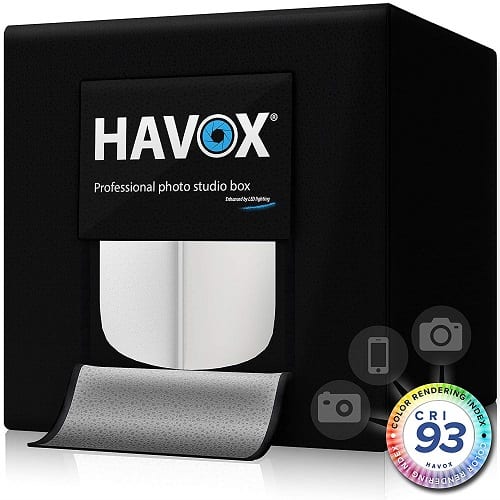
Now this is one I was extremely excited to write about. HAVOX did something that nobody else has been able to do for this price range, and with this level of portability.
First and foremost, this entire system is just under 9 lbs, and once you read about everything it can do, you’re going to be blown away.
First of all, it’s a perfect 24” x 24” x 24” cube, and while that’s a touch bit smaller than the AmazonBasics box we listed earlier, it still gets the job done.
Portable lightboxes aren’t easy to design, but even so, HAVOX was able to include an automatic rotating plate inside to give your product videos a bit of a 360° spin.
Just to clarify on the sizes, there are three different sizes available, but once you get into the 32” x 32” x 32” model, the price jumps up significantly.
Everything is powered by a USB cable, which powers up to 13,000 lumens of LED power to shine down on your products in the box.
Whether you’re shooting product videos or not, there’s one feature here that will come in handy.
That’s dimmable lighting that doesn’t flicker when you engage the switch, so you can gently lower the lighting down to dim it out, and you won’t see that jolt or skipping of the light when you operate it.
Assembly is listed as being fairly easy, but there’s always a catch.
I would wager that if you haven’t assembled a lightbox in the past, you might encounter some difficulty with it initially, making the assembly time about a half-hour.
It’s true that this entire unit is portable, but I wouldn’t disassemble it to move it around.
To directly compare it to our top pick—being the AmazonBasics lightbox—this isn’t quite as convenient for on-the-go endeavors.
It doesn’t fold down unless you disassemble it, and when you do, there’s a big chance of losing small pieces, so you would be better off just hoisting the whole thing into the trunk of your car.
Portable, just not quite so convenient.
JHS-TECH Mini Photo Studio Box
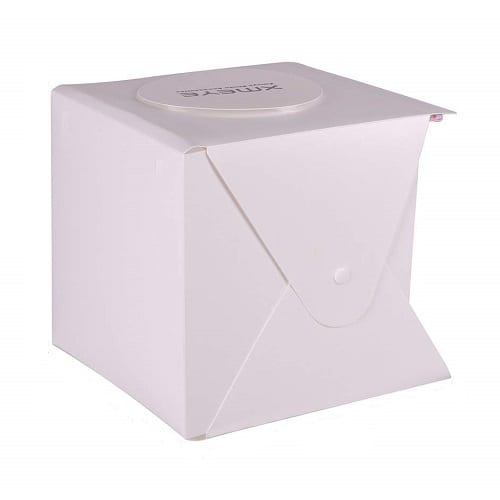
While it might seem simple at first, this mini studio box by JHS-TECH does a fantastic job without all the bells and whistles.
There aren’t as many attributes to point out, like there have been with the other models we’ve reviewed so far.
It’s lightweight at just 10.4 ounces, but that also means it’s a bit more fragile.
A drop off the table could spell its end, so just be sure of yourself when you go to maneuver it.
If you enjoy low energy consumption electronics, then this is basically designed just for you.
Everything runs on a simple USB cord, so you don’t have to charge a lithium-ion battery pack or use a 12V adapter into the wall. Pure and simple.
While this is bright, it’s the least bright of all the models on this list.
Granted, we’re looked at some with tens of thousands of lumens, so it’s a grand scale to measure on.
The box isn’t enormous; it measures about 10” x 9”, so you’re not going to get as much use out of it if you’re mostly photographing larger items.
To delve a bit deeper here, I wanted to address the price tag. It’s inexpensive, and it gets the job done fairly well, but that doesn’t leave a lot of room for JHS-TECH to spend on customer service.
The product is solid, but their support team is a joke. It’s not wise to rely on them, even if it’s just for warranty fulfillment.
This product is covered instead by Amazon’s 90-day product support, which is far better.
Since it’s shipping with Amazon, they’re more likely to replace a broken product (if it’s a shipping issue) since they have a long history of doing so.
When it comes to portability, they do a fair job. Because the box is simple plastic, you can fold it up and take it on the go.
There’s no inclusion of metal buttons to snap the plastic side walls together; even the buttons are plastic, so they just snap in and out without a hassle.
This is beneficial for transport and closing up shop, but if you’re too rough and you happen to dent the sidewalls, it could create visual disturbances in photographs or catch a bit of shade.
Just be cautious. I would recommend this to anyone that’s just getting started in this space and wants to test things out.
ESDDI Portable Photo Studio Light Box w/ Adjustable Brightness
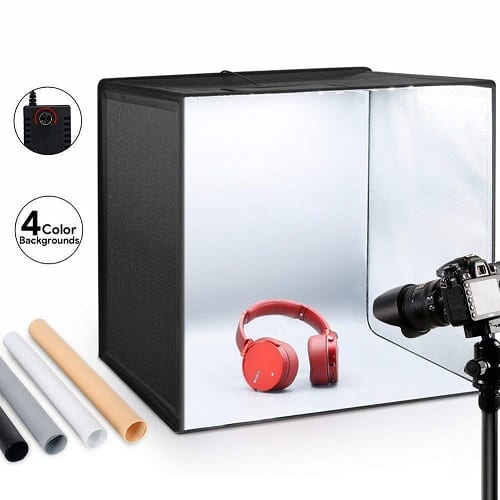
Last but not least, ESDDI’s take on the photo lightbox has its power, and it has its flaws.
First and foremost, you have over 26,000 lumens of power here with some control over the brightness, effectively allowing you to control the contrast between your product and the backdrop with ease.
One of the most important aspects of your lightbox and the way it reveals a finished photograph is the color temperature.
Thanks to the 120 LED lamps, you’re going to get 5500K temperatures to handle just about any project you could think of.
The size is agreeable enough—19.7 inches all around.
For most small and medium-sized photography projects, this is exactly what you’re going to need. But now is where I start discussing the downsides.
It’s a very portable box that disassembles in about a minute, but that’s because it’s using velcro on all sides of each side wall.
While this is good for a while, the velcro is eventually going to leave cracks in between the panels, which could impact your shoots.
Velcro is easy enough to keep clean and clear, but it is easier to destroy it over time and careful disassemblies.
I mentioned all of that lumen power. It’s good, if you know how to use it effectively.
You might find yourself turning this down to about half capacity because of the potential glare on products.
It’s not the perfect solution, but it’s a middle-of-the-road item that works for those of you who are trying to take things a bit more seriously.
Best LED Light Box Tracer
Tikteck A4 Ultra-Thin Portable LED Light Pad
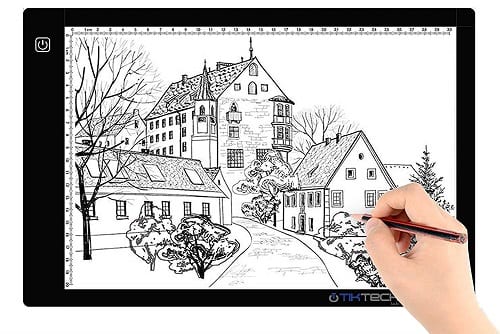
If you’re trying to get the best lightbox photography results imaginable, you might run into one problem with basic smartphone lightboxes, and that’s the shadows from the bottom.
Some items in your lightbox just cast shade no matter what. That’s where Tikteck’s LED board comes into play.
Place this on the bottom of your lightbox for a bit of added power.
While there’s no specific lumen count (because some manufacturers apparently don’t think it’s 8important to list), this panel is ultra bright, because it’s also designed as an artist’s sketch board, not to be confused with an artists’ tablet.
The base lights up, images show through a piece of paper, and artists can take tracing paper over it to begin practicing new designs.
However, with your imagination, you could use it strictly in your lightbox for an added effect.
Everything is rechargeable through the USB plug-in, and runs off of a lithium-ion battery.
If you’re going to be using this for extended periods of time, I recommend bringing along a power bank, because the battery was not designed for longevity.
Furthermore, it takes a while to charge from a standard USB plug-in to a 12V outlet, so plan your time accordingly before you expect to use this.
Regardless of your current lightbox design, Tikteck is there to add a bit of flair and visibility at the same time.
On the bottom of your light pad, you’re going to have rubber grip strips to keep everything in place.
This means that even if you have to rearrange the placement of your product, it’s not going to shift around at all.
Smartphone Photo Studio Box Buying Guide and FAQ
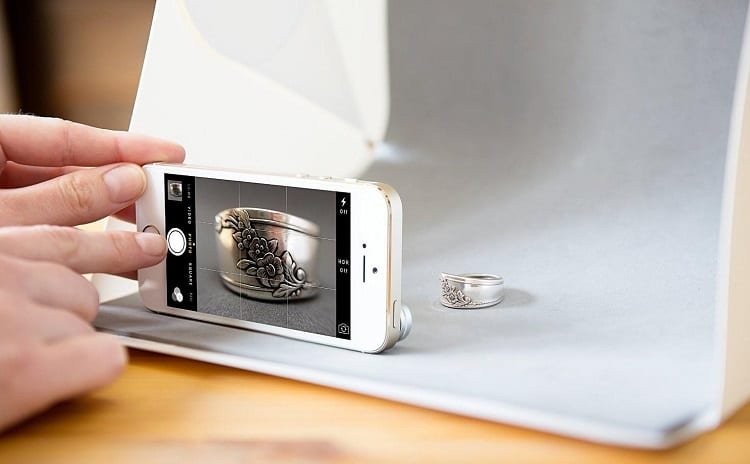
Features to Look for in Photo Lightboxes
Size
This is going to depend on your personal needs, but the size is going to dictate the cost, because a larger lightbox requires more LEDs, a higher lumen output, more materials, and so on.
It can get a bit pricey. If you’re taking photographs of small electronics or handheld products, a simple 36” x 36” x 36” box should be more than you need, but if you’re photographing clothing and other large or awkwardly sized items, you can expect the size and cost of your light box to double.
Lumens (Brightness)
The lumens indicate the brightness, meaning the more, the better.
Different photo subjects are going to require different amounts of light, so you’re going to have to plan it accordingly.
However, you want enough lumens to eliminate shadows and create a beautiful contrast without giving a glare or reflection off of your photograph’s subject.
Sliders
So how do you control those lumens?
Adjustable sliders to change the brightness settings at the flick of the wrist.
Some lightboxes will come with a bluetooth connection and an app that you can use, but others will simply have a manual control somewhere near the power supply where you can adjust it.
This is necessary for getting the perfect light. Some light boxes may simply have different settings, such as 25% brightness, 50%, and so on.
Rotating Base
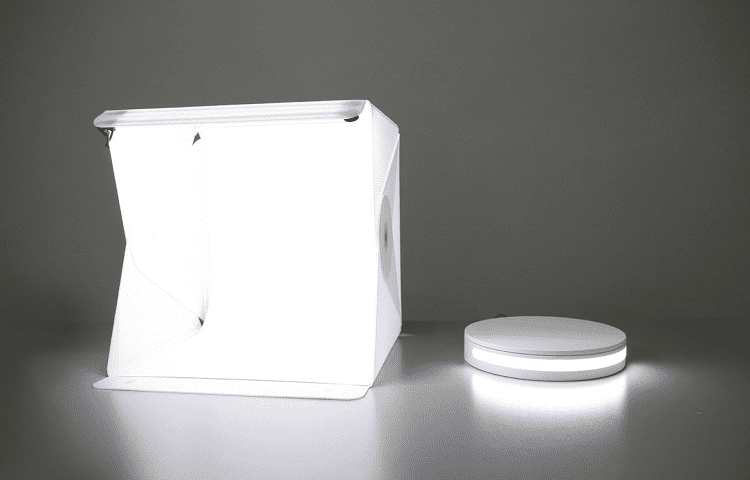
This is a higher-end feature ot lightboxes, but it can really take your product videography to the next level.
These bases simply spin very, very slowly to give a more aesthetic appeal to the subject of your photo.
You can usually adjust the time it takes for the plate to spin around, within reason, so that you can put a voice overlay on a rotating product for a professional home shopping network kind of feel.
Material
You’ll find a lot of plastic boards that can be snapped together, which can be good, but also fragile.
Look closely at the materials to determine the durability of a lightbox.
Heavier, more durable materials may impact how portable your lightbox ends up being.
What Does a Lightbox Do?
Lightboxes are specifically designed to add contrast behind an item or person, and provide enough light to eliminate nearly all shadows (some products look better with a slight edge of a shadow underneath them).
The best photo box provides plenty of lumens worth of light, which can make your product or the general subject of your photograph the center of attention to your viewer.
Light boxes are generally used for product photos for online listings, like Amazon or Ebay.
Lightboxes add a professional element to an otherwise unappealing or non-exciting photograph.
They can be used in accordance with different backdrops apart from just white ones if you’re trying to create something unique.
Lighting is one of the most important elements of any photograph.
It can turn something unappealing, dim or dark into the center of attention, and improve how we view items due to the appearance of different angles provided by or eliminated by the light.
What is a UV Light Box Used for?
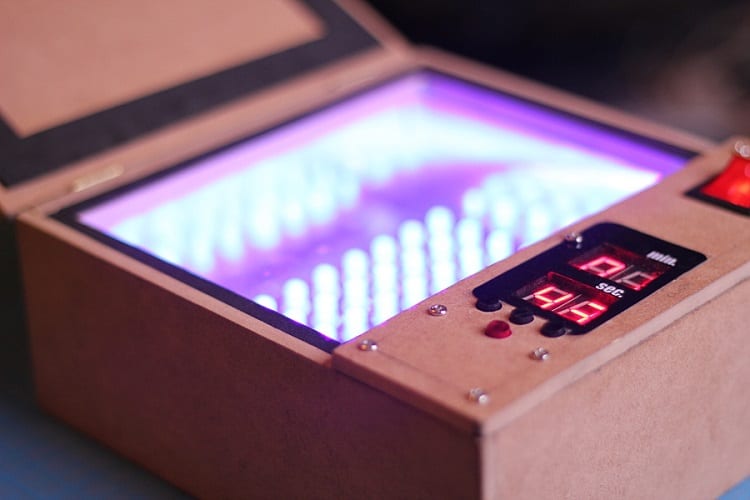
UV light boxes aren’t necessarily used as lightbox photography kits—instead, they’re designed to help with screen printing.
UV light can be concentrated in a small space, usually a box that you can close, and aid with screen printing for clothing and on laminate.
Can You Use a Mobile Phone for Product Photography?
It’s actually one of the most effective, low-cost ways to take product photos.
Now that we’re in an age where teenagers can start multimillion dollar businesses from their laptops, you’re basically able to make any tool at your disposal work in some way.
It all comes down to megapixels and pixel size.
You’re going to see a lot of fighting between these two concepts as you research more photography equipment and gear.
Megapixels matter; they define how good a camera is, but the pixel size also comes into account.
You want large pixels on a smartphone camera. Because of the size, you’re going to commonly see small megapixels on these miniature camera lenses.
If you had a 12 MP camera with small pixels, it would be worse than a 12 MP camera with large pixels.
But because many companies are aware that consumers don’t know this, the ride the marketability of a product based on the megapixel rating in the camera.
You want high megapixels, and large megapixels to get the best photos.
The brilliant thing about product photography is that if you use a lightbox and a tripod to get an even shot, you can use an 8 MP camera or lower to pull out some high-end shopping network quality photographs that are going to put products in the best possible light.
What Are the Best Settings for Product Photography?
When you’re using a product photography lightbox, you have to pay close attention to your settings to get the best pictures possible.
These are the three main settings you need to look at:
- ISO Value – ISO values help define better photographs through sensitivity, meaning that the higher your ISO, the finer the details will be.
- Aperture – On some phones, you can mess with this settings, but not all of them. The aperture values can be determined by properly using these other two settings, but if you’re able to get some very advanced apps or access to your camera, you can try to get an aperture rating indicator and mess with it by using ISO and exposure to your advantage.
- Exposure Time – Exposure time will toy with your camera’s settings as it adjusts the camera in your favor, and affects the brightness at the same time. Depending on your exposure times, you can either look like you’re capturing a moment in the middle of its bliss, or it can look like time has frozen still only for you.
Your Smartphone is an Investment
You can make some truly amazing videos, and take some optimal photographs with your smartphone, you just need to know how.
Lightboxes usually serve the purpose of selling your personal items online, or if you’re a photographer for products that are listed on Amazon and other digital retailer sites.
Whatever you need it for, you now know the best of the best to get started with.

